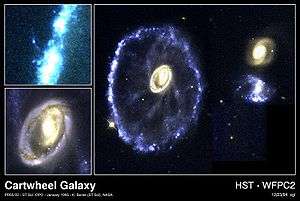Cartwheel Galaxy
| Cartwheel Galaxy | |
|---|---|
 This image shows the Cartwheel Galaxy as seen from Hubble Space Telescope | |
| Observation data (J2000 epoch) | |
| Constellation | Sculptor |
| Right ascension | 00h 37m 41.1s[1] |
| Declination | −33° 42′ 59″[1] |
| Redshift | 9050 ± 3 km/s[1] |
| Distance | 500 Mly (150 Mpc)[2] |
| Apparent magnitude (V) | 15.2[1] |
| Characteristics | |
| Type | S pec (Ring)[1] |
| Size | ~130,000 ly (diameter)[2] |
| Apparent size (V) | 1′.1 × 0′.9[1] |
| Notable features | Ring shape |
| Other designations | |
| MCG-06-02-022a,[1] PGC 2248[1] | |
The Cartwheel Galaxy (also known as ESO 350-40 or PGC 2248) is a lenticular galaxy and ring galaxy about 500 million light-years away in the constellation Sculptor. It is an estimated 150,000 light-years diameter, and has a mass of about 2.9–4.8 × 109 solar masses; it rotates at 217 km/s.[3]
It was discovered by Fritz Zwicky in 1941.[4] Zwicky considered his discovery to be "one of the most complicated structures awaiting its explanation on the basis of stellar dynamics."[4][5]
An estimation of the galaxy's span resulted in a conclusion of 150,000 light years, which is slightly larger than the Milky Way.[6]
Structures
The Cartwheel galaxy shows non-thermal radio and optical spokes, but they are not the same spokes.[7]
Evolution
The galaxy was once a normal spiral galaxy before it apparently underwent a head-on collision with a smaller companion approximately 200 million years ago (i.e., 200 million years prior to the image).[3][8] When the nearby galaxy passed through the Cartwheel Galaxy, the force of the collision caused a powerful shock wave through the galaxy, like a rock being tossed into a sandbed. Moving at high speed, the shock wave swept up gas and dust, creating a starburst around the galaxy's center portion that were unscathed. This explains the bluish ring around the center, brighter portion.[9] It can be seen that the galaxy is beginning to retake the form of a normal spiral galaxy, with arms spreading out from a central core.[8]
Alternatively, a model based on the gravitational Jeans instability of both axisymmetric (radial) and nonaxisymmetric (spiral) small-amplitude gravity perturbations allows an association between growing clumps of matter and the gravitationally unstable axisymmetric and nonaxisymmetric waves which take on the appearance of a ring and spokes.[5]

X-ray sources
The unusual shape of the Cartwheel Galaxy may be due to a collision with a smaller galaxy such as those in the lower left of the image. The most recent star burst (star formation due to compression waves) has lit up the Cartwheel rim, which has a diameter larger than the Milky Way. Star formation via starburst galaxies, such as the Cartwheel Galaxy, results in the formation of large and extremely luminous stars. When massive stars explode as supernovas, they leave behind neutron stars and black holes. Some of these neutron stars and black holes have nearby companion stars, and become powerful sources of X-rays as they pull matter off their companions (also known as ultra and hyperluminous X-ray sources).[10] The brightest X-ray sources are likely black holes with companion stars, and appear as the white dots that lie along the rim of the X-ray image. The Cartwheel contains an exceptionally large number of these black hole binary X-ray sources, because many massive stars formed in the ring.

References
- 1 2 3 4 5 6 7 8 "NASA/IPAC Extragalactic Database". Results for Cartwheel Galaxy. Retrieved 2006-11-25.
- 1 2 Moore, Patrick (2000). The Data Book of Astronomy. CRC Press. p. 318. ISBN 0-7503-0620-3.
- 1 2 Amram P, Mendes de Oliveira C, Boulesteix J, Balkowski C (February 1998). "The Hα kinematic of the Cartwheel galaxy". Astron. Astrophys. 330: 881–93. Bibcode:1998A&A...330..881A.
- 1 2 Zwicky F (1941). in Theodore van Karman Anniversary volume Contribution to Applied Mechanics and Related Subjects. Pasadena, California: California Institute of Technology. p. 137.
- 1 2 Griv E (Oct 2005). "Origin of the Cartwheel Galaxy: disk instability?". Astrophys. Space Sci. 299 (4): 371–85. Bibcode:2005Ap&SS.299..371G. doi:10.1007/s10509-005-3423-5.
- ↑ "Amazing Space- Fast Facts: Cartwheel Galaxy". Amazing Space. 2008. Retrieved 2009-07-03.
- ↑ Mayya YD; et al. (2005). "The Discovery of Spiral Arms in the Starburst Galaxy M82". Astrophys. J. 628 (1): L33. arXiv:astro-ph/0506275. Bibcode:2005ApJ...628L..33M. doi:10.1086/432644.
- 1 2 "Cartwheel Galaxy". College of Southern Nevada. Retrieved 2009-07-03.
- ↑ Jane Platt (November 1, 2006). "Cartwheel Galaxy Makes Waves in New NASA Image". NASA. Retrieved 2009-05-15.
- ↑ "The Cartwheel Galaxy – Introduction". Harvard-Smithsonian Center for Astrophysics. January 22, 2009. Retrieved July 29, 2013.